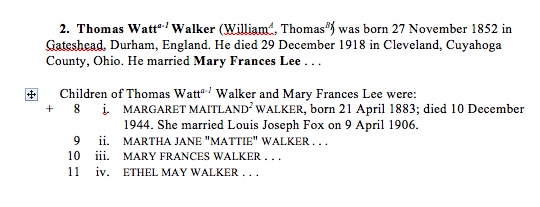Numbering 3: Adoptions and Children of Multiple Marriages
-
Created on 13 April 2016
By Judy Kellar Fox, CG®
The Walker family showed us how to accommodate numbering children born to unknown fathers in the second numbering post. Complexities continue in Generation Two with two types of informal adoption and children born to a descendant by two spouses.
Remember that we are looking at three numbers used in a descending genealogy:
- Individual numbers, arabic numbers (1, 2, 3, 4 . . .);
- Generation numbers, a superscript number in italic font (1, 2, A, B, a, b); and
- Birth-order numbers, a lowercase roman numeral (i, ii, iii . . .).
Parenthetical summaries of descent outline each descendant’s ancestry. They appear after the descendant’s name in the first line of the biographical sketch, for example, “8. Margaret Maitland2 Walker (Thomas Watta-1, WilliamA, ThomasB) was born . . .”
In all cases our authority on numbering is Joan Ferris Curran, Madilyn Coen Crane, and John H. Wray, Numbering Your Genealogy: Basic Systems, Complex Families, and International Kin, ed. Elizabeth Shown Mills, rev. ed. (Arlington, Va.: National Genealogical Society, 2008).
Generation Two
Only two children of WilliamA Walker and Margaret Lauderdale fathered and raised children, William’s biological son Thomas Watta-1 and Margaret’s son Edward1. Their parenthetical summaries of descent reflect their biological or social English ancestry through father WilliamA and grandfather ThomasB.
When she was still unmarried, the eldest daughter of Thomas Watta-1 and Mary bore a child to an unknown man. Thomas and Mary raised granddaughter Dorothy as their own child, as a sister to her mother. Dorothy takes the next individual number after Thomas and Mary’s children (12).[1] She has no child-list number, as she was not their biological child. Her introduction, below, cross-references her biological mother Margaret Maitland2, no. 8.[2] Her superscript generation number follows that of her biological mother, not her adoptive parents.[3] 
Individual number, no birth-order number, generation number following her mother's
Thomas Watta-1 also had a stepson borne by his wife Mary to a father unknown before she married Thomas. Albert was raised by his Lee grandparents until his mother’s marriage. Although Thomas did not adopt Albert legally, he raised him as his own son, and Albert consistently used the Walker surname throughout his life. Adoptee Albert takes a sequential individual number after Thomas and Mary’s children (even though he was born before them) and after Dorothy, their biological granddaughter.[4] Like Dorothy, Albert does not take a child number because he was not a biological child of this union.[5] His generation number is one (1) because he is the first of his biological line to take the Walker surname.[6] A parenthetical description explains his origins.[7] 
Individual number, no birth-order number, generation number of 1 as the progenitor of a new biological Walker line
As we saw in the last post, Edward1 Walker was neither a stepson of nor adopted by William2 Walker, but his mother treated him as if he were William’s son. He retains the Walker surname and the continuity of the social family in his parenthetical summary of descent.[8]
Individual number, generation number 1, explanation of relationship to William in the parenthetical summary of descent
Edward married twice and fathered children by both wives. The children of each marriage receive sequential birth-order numbers beginning with one (i). Sadie’s children are i–iii, and Margaret’s son is i. They could just as well be numbered sequentially as children of the same descendant father, i–iv, without focusing on their mothers' roles.[9]
Next time we’ll look at another example of numbering children by multiple partners.
What similar examples have you found in your family?
[1] Numbering Your Genealogy, 24, bullet 1. This is a variation on the example in Numbering Your Genealogy, 22, no. 46 (adopted child of no. 42, who has no biological children).
[6] Numbering Your Genealogy, 18, bullet 5, and 25, bullet 1.
[7] For the format of this explanation, see Numbering Your Genealogy, 24, “Adoption—Child of a Spouse.”
[8] Numbering Your Genealogy, 18, bullet 7. The invention of “posthumous stepson” follows the idea of informal adoption, as in 18, last paragraph, and 24, “Adoption—Child of a Spouse.”
[9] Numbering Your Genealogy, 12, “Birth-order Numbers,” and examples on p. 6, children of Matthew Moss (numbered as separate families), and p. 7, children of Matthew Moss (numbered all together).
